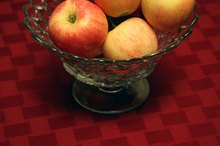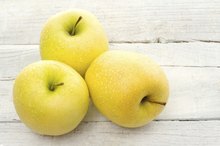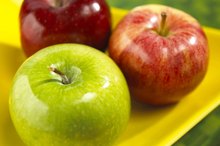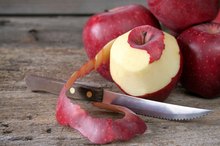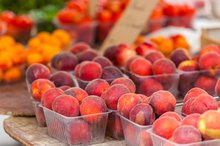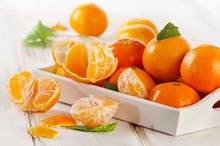What does fact checked mean?
At Healthfully, we strive to deliver objective content that is accurate and up-to-date. Our team periodically reviews articles in order to ensure content quality. The sources cited below consist of evidence from peer-reviewed journals, prominent medical organizations, academic associations, and government data.
- Nutrition Journal: Apple Phytochemicals and Their Health Benefits
- Nutrition Journal: Apple Phytochemicals and Their Health Benefits
The information contained on this site is for informational purposes only, and should not be used as a substitute for the advice of a professional health care provider. Please check with the appropriate physician regarding health questions and concerns. Although we strive to deliver accurate and up-to-date information, no guarantee to that effect is made.
What Nutrients Are Lost When an Apple Oxidizes?
A member of the rose family, the apple is a fruit with many health benefits 4. Apples are rich in polyphenols, a type of phytochemical. Phytochemicals are not vitamins, but rather plant-derived nutrients useful to the body in ways that are not considered critical to life. The polyphenols in apple are powerful antioxidants that boost immunity and neutralize damaging free radicals. According to Dr. Ray Strand, free radicals cause cellular damage and play a key role in development of degenerative ailments such as arthritis and heart disease.
Enzymatic Browning
The fresh, pale surface of the newly sliced apple flesh turns brown when exposed to air -- a process called enzymatic browning 3. Enzymatic browning is visible evidence of the apple's oxidation 3. This process starts when an enzyme called polyphenoloxidase (PPO) reacts with oxygen and the phenolic compounds contained within the apple. When an apple is cut, PPO begins to interact with oxygen and phenolic compounds, called tannins, within the apple. PPO's action upon tannins culminates in the production of melanins, which have a dark brown pigment that is characteristic of enzymatic browning 3.
According to the Food and Agriculture Organization of the United Nations (FAO), ezymatic browning is responsible for approximately 50 percent of losses during fruit and vegetable production.
Quercetin
What Is the Nutritional Value of a Gala Apple?
Learn More
The phenolic compound quercetin is a flavanoid. Flavanoids are the chemical compounds that determine the color of fruits. Quercetin is a powerful antioxidant. Located in the apple's skin, it has a stronger antioxidant capacity than vitamin C. A peeled apple has less phenolic compounds and has less oxygen-scavenging capacity than an apple with its skin. Thus, the antioxidant potency of an apples' flavanoids is reduced by the process of oxidation.
As of 2010, the American Cancer Society reports, quercetin is being studied to evaluate its usefulness in the prevention and treatment of cancer, heart disease and prostatitis; the organization cannot make any recommendations until these clinical studies are complete 5. Quercetin is available as a nutritional supplement; consult your doctor before taking quercetin supplements.
- The phenolic compound quercetin is a flavanoid.
- As of 2010, the American Cancer Society reports, quercetin is being studied to evaluate its usefulness in the prevention and treatment of cancer, heart disease and prostatitis; the organization cannot make any recommendations until these clinical studies are complete 5.
DOPA
The phenolic compound dihydroxyphenylalanine, also known as DOPA, is the precursor of dopamine, a neurotransmitter that plays a central role in the reward system in your brain. It plays a role in mental health, with low dopamine putting you at risk for social anxiety. PPO interacts with DOPA and oxygen to form dopaquinone and eventually melanin. By interacting with DOPA, PPO reduces the amount of DOPA available in an apple.
- The phenolic compound dihydroxyphenylalanine, also known as DOPA, is the precursor of dopamine, a neurotransmitter that plays a central role in the reward system in your brain.
- It plays a role in mental health, with low dopamine putting you at risk for social anxiety.
Vitamin C
Calories in a Yellow Apple
Learn More
Vitamin C, or ascorbic acid, is a water-soluble vitamin known for its antioxidant and immunity-enhancing properties. Apples contain vitamin C. According to the FAO, Vitamin C is destroyed by oxidation, and is the vitamin most easily lost during processing, storage, and cooking. Vitamin C has an inhibitory effect upon enzymatic browning 3. Application of vitamin C or lemon juice to the cut surface of an apple will temporarily arrest enzymatic browning 3.
- Vitamin C, or ascorbic acid, is a water-soluble vitamin known for its antioxidant and immunity-enhancing properties.
Related Articles
References
Writer Bio
Verneda Lights has been writing and editing articles about art, science, health, business, history and religion since 1970. Her work has appeared in "Essence," "Working Women Stories & Poems" and "National Geographic." She holds a Bachelor of Arts in history from Bryn Mawr College, a medical degree from University of Pennsylvania School of Medicine and a Master of Business Administration from Strayer University.
